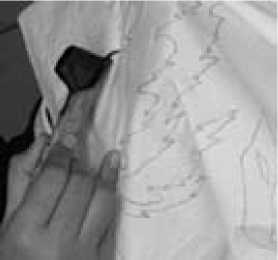1. Intr oduc tion
Human-computer interaction related to productiv'ty and innovation has yielded a lot of discussions
and impacts in improving a lot of progress in the development of user-friendly software (Zhapiris &
Ang, 2009). However, our age has witnessed that computational technology has changed a lot more
than we might like to imagine (Asaolu, 2006), be it culture (Edward, 1994), economy (Vaaler &
McKnight, 2000), politics (Friedma n, 2005), and even changed the way we see ourselves, and the
social life surrounding us (Kraemer, et al, 1995). A lot of theoretical discoveries in science and
technology nowadays are easily conveyed and thus implemented to cope with some problems or
simply just boost our living performance.
Batik is a famous and unique traditional heritage from Indonesia. Its uniqueness comes from its
production process - which known as “mbatik”, its motifs, and its values. Since cultural and art
product could become an economic product (Heilbrun & Gray, 2004), as artistic and unique fabric
product, batik could be a very valuable product economically, even in the modern era like today.
However, besides as a economic product, batik is considered having an astonished characteristic on
its motifs. Batik motifs and orna mentation, whi ch is born and constructed from cognitive process of
human being when she drawn her surrounding nature, is found to have a very interesting complexity
degree. This feature is regarded as one of interesting aspect to be researched and innovated using
science and technol ogy.
Recent development in science and technology has made simulation growing natural process in silico
becomes possible. It is also possible to generate Batik motifs and ornamentation - which found has a
fractal property in its complex geometry - computationally. Situngkir (2008) have been classified
innovation types of batik motifs and found that batik motif could growt h computationally by
incorporating fractal generation algorithm, such as iterated function system, complex plane, etc.
In order to design, evaluate, and implement computational systems for batik motifs generation, the
algorithms ment ion above have been implemented in Java TM platform. This software is constructed
to explore possibilities on batik motifs generation, and to evaluate the implementation of these
motifs in mbatik process.
The interaction of this computing platform with users in generating new batik motif is conducted in
form of workshop involving nine senior high school students. Interestingly, we have found that
students could be easily perceived whether computationa lly generative motif resulted by fracta l -
generating software is appropriate batik motif or not. The emergence patterns of batik design also
have found when these motifs are pai nted to fabric material by using tra ditional batik process. The
paper reports the evaluation of the workshop.

Figure 1.
Mbatik process uses “canthing” to draw the hot wax to fabric to be
resisted in the colo ring process
More intriguing information
1. 03-01 "Read My Lips: More New Tax Cuts - The Distributional Impacts of Repealing Dividend Taxation"2. Implementation of Rule Based Algorithm for Sandhi-Vicheda Of Compound Hindi Words
3. The Variable-Rate Decision for Multiple Inputs with Multiple Management Zones
4. Parallel and overlapping Human Immunodeficiency Virus, Hepatitis B and C virus Infections among pregnant women in the Federal Capital Territory, Abuja, Nigeria
5. DEVELOPING COLLABORATION IN RURAL POLICY: LESSONS FROM A STATE RURAL DEVELOPMENT COUNCIL
6. Influence of Mucilage Viscosity On The Globule Structure And Stability Of Certain Starch Emulsions
7. L'organisation en réseau comme forme « indéterminée »
8. MULTIMODAL SEMIOTICS OF SPIRITUAL EXPERIENCES: REPRESENTING BELIEFS, METAPHORS, AND ACTIONS
9. The name is absent
10. Self-Help Groups and Income Generation in the Informal Settlements of Nairobi